Environment: milieu / climate zone / depth range / distribution range
Écologie
marin récifal; profondeur 3 - 30 m (Ref. 9710). Tropical
Western Central Atlantic: Jamaica, Cayman Islands, Florida (USA), Bahamas, Greater Antilles, Lesser Antilles and Honduras.
Taille / Poids / Âge
Maturity: Lm ? range ? - ? cm
Max length : 13.0 cm TL mâle / non sexé; (Ref. 9710)
Head yellow, body black to brown (extent of the yellow and black portions can vary). The yellow and black portions are divided by a diagonal line that extends from the nape posteriorly and ventrally to the anal fin. Face and all fins yellow. Pectoral fins pigmented. Head with iridescent blue lines (as in butter hamlet but the lines are fewer in number and more pronounced). Two black spots bordered by iridescent blue may be found on the snout in the region of the nares.
A solitary species (Ref. 26340) inhabiting rocky or coral reefs, often near staghorn coral (Ref. 9710). Travels in pairs and remains close to the bottom (Ref. 26938).
Life cycle and mating behavior
Maturities | Reproduction | Spawnings | Egg(s) | Fecundities | Larves
Domeier, M.L., 1994. Speciation in the serranid fish Hypoplectrus. Bull. Mar. Sci. 54(1):103-141. (Ref. 26407)
Statut dans la liste rouge de l'IUCN (Ref. 130435)
Menace pour l'homme
Harmless
Utilisations par l'homme
Pêcheries: commercial; Aquarium: Commercial
Outils
Articles particuliers
Télécharger en XML
Sources Internet
Estimates based on models
Preferred temperature (Ref.
123201): 26.6 - 28.2, mean 27.5 °C (based on 605 cells).
Phylogenetic diversity index (Ref.
82804): PD
50 = 0.5000 [Uniqueness, from 0.5 = low to 2.0 = high].
Bayesian length-weight: a=0.01778 (0.00680 - 0.04650), b=3.03 (2.80 - 3.26), in cm total length, based on LWR estimates for this (Sub)family-body shape (Ref.
93245).
Niveau trophique (Ref.
69278): 3.8 ±0.4 se; based on size and trophs of closest relatives
Résilience (Ref.
120179): Haut, temps minimum de doublement de population inférieur à 15 mois (Preliminary K or Fecundity.).
Fishing Vulnerability (Ref.
59153): Low vulnerability (10 of 100).
Nutrients (Ref.
124155): Calcium = 85.4 [47.3, 169.6] mg/100g; Iron = 0.684 [0.364, 1.305] mg/100g; Protein = 18 [16, 20] %; Omega3 = 0.132 [0.077, 0.222] g/100g; Selenium = 25.3 [13.8, 51.5] μg/100g; VitaminA = 94 [25, 406] μg/100g; Zinc = 1.36 [0.86, 2.08] mg/100g (wet weight);
